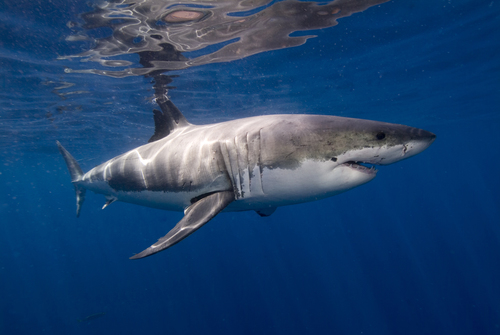
Great White Shark
The Atlantic bluefin tuna (Thunnus thynnus) is a highly migratory, predatory fish renowned for its size, speed, and commercial value. It is a critical part of the marine ecosystem and plays a significant role in both the economy and culture of many regions. This species faces significant conservation challenges due to its high demand.
30 70 years
Lifespan
600 cm
Length
Vulnerable
Conservation Status
56 km/h
Swimming speed
Carnivorous
Diet
Highly Migratory
Migration
Appearance Overview
The Atlantic bluefin tuna is a large, streamlined fish with a metallic blue body and a silvery underside.
Color
Dark metallic blue on top, silvery underside
Body Shape
Torpedo-shaped, built for speed and endurance
Fins
Two dorsal fins, the first depressible; small finlets running from dorsal and anal fins to tail
Keel
Strong lateral keel on the caudal peduncle
Length
Up to 13 feet (4 meters)
Weight
Up to 2,000 lbs (907 kg)
Diet
Carnivorous, feeding on a variety of fish, squid, crustaceans, and occasionally on kelp and other sea plants.
Feeding Behavior
Highly migratory, they are opportunistic predators, using their speed and agility to hunt. They often feed cooperatively, herding and trapping prey.
Social Behavior
Forms large schools, especially during migration and spawning, but can also be found in smaller groups or solitary.
Commercial Relevance
Extremely high value, particularly in the sushi and sashimi markets. It is one of the most expensive fish species globally.
Conservation measures
International fishing quotas, regional fisheries management organizations (RFMOs), and some marine protected areas. Efforts also include tagging programs to monitor populations.
Status
Endangered
Threats
Overfishing is the primary threat, driven by high demand in international markets. Climate change and habitat degradation also impact populations.
Habitat Distribution
Depth Range
Typically found in surface waters to depths of 50-500 meters, but can dive to over 1,000 meters.
Geographic Range
Western and Eastern Atlantic Ocean, Mediterranean Sea, and Black Sea
Preferred Environment
Prefers temperate and subtropical waters; highly migratory, often found in open ocean and coastal areas.
Reproduction and Life Cycle
Breeding Habits
Spawns in warm waters, primarily in the Mediterranean Sea and the Gulf of Mexico. Spawning occurs in large aggregations.
Development Stages
Eggs hatch into larvae that feed on plankton. Juveniles grow rapidly, feeding on small fish and invertebrates. They mature into large, pelagic predators.
Fecundity
Females can produce up to 30 million eggs per spawning season, releasing them in batches.
Maturity Age
Reaches sexual maturity at around 4-8 years in the Mediterranean and 8-12 years in the western Atlantic.
Faqs about Great White Shark
How long do Atlantic bluefin tuna live?
Atlantic bluefin tuna can live up to 40 years, though this is rare due to fishing pressure.
Where are Atlantic bluefin tuna found?
They are found in the western and eastern Atlantic Ocean and the Mediterranean Sea.
Are Atlantic bluefin tuna warm-blooded?
They are warm-blooded, which is unusual among fish, allowing them to maintain high body temperatures and swim at high speeds in cold waters.
Do Atlantic bluefin tuna migrate?
Yes, they are highly migratory, traveling thousands of miles across the Atlantic Ocean for feeding and spawning.
What is the ecological role of Atlantic bluefin tuna?
Atlantic bluefin tuna are at the top of the food chain and help regulate the populations of their prey.
Why are Atlantic bluefin tuna endangered?
The main threat is overfishing, which has severely depleted their populations.
Copyright @ Nature Style Limited. All Rights Reserved.
 English
English